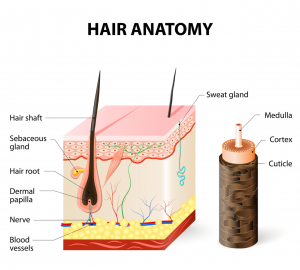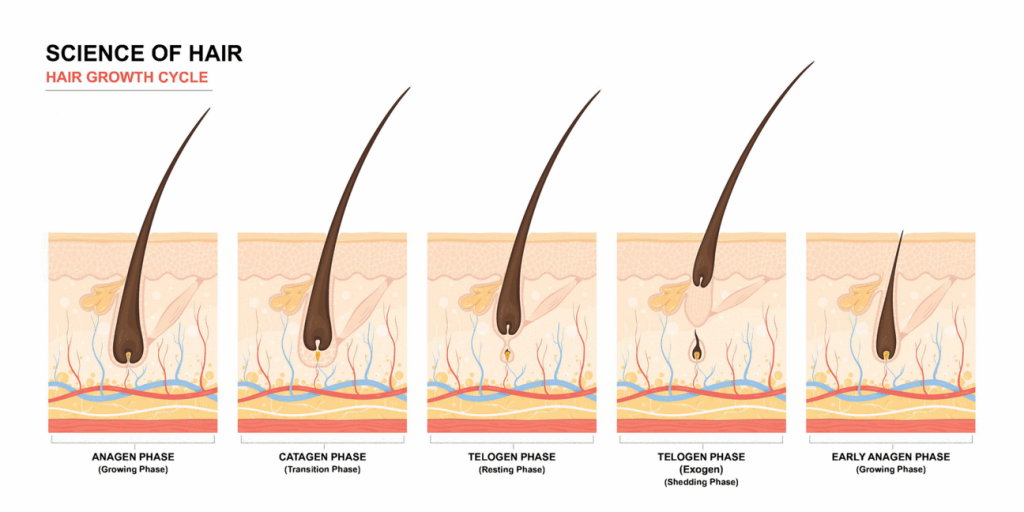There are at least 46 different known types of hair loss, all of which can be quite distressing for the person experiencing it.
It is a condition that can affect any person at any time of their life.
One of the first thing to recognise the problem of hair loss is to determine the reason behind it so that it can be treated correctly.
Here is a little bit about hair and it’s life cycle.
The follicles are where each strand of hair grows from, these are located int the dermis of the skin under the scalp, hair will grow to approximately 0.92cm to 1.25cm per month.
On average there are 100 000 follicles in the scalp of most human beings and during its lifetime each follicle will can produce 20 individual hairs.
Hair is made of proteins called keratin and it is one of the strongest fibres there is and is able to stretch to 1.5 times its own length.
Hair colour, texture and density are all inherited factors.
In the anagen stage of the hair life cycle, the hair grows and can last anything between two to six years depending on the genetic origin of the hair.
The catagen stage lasts between two to three weeks, this is the resting stage where the hair follicle shrinks and the papilla detaches and rests by cutting off the blood supply to the hair.
The telogen stage is when the follicle sits dormant and this stage can last between one to four months.
10% of hair is in the catagen or telogen stage and the remaining 90% is actively growing in the anagen stage. This means if the scalp has the correct environment and nutrition, new hair is being continually produced to replace shedding hair.
On average most people will shed between 50 to 100 hairs per day and this is completely normal.
If due to diet, health, nutritional or environmental reasons you are losing more hairs than you are actively growing your hair will begin to thin this can take a while before you begin to notice the visible signs.
Our aim at Colabella is to stabilise hair loss, to try to improve scalp and hair health and to maintain healthy follicles that are still there.
This can be done and has been done successfully by following a treatment plan and a course of treatment designed for each individual condition.
Each client will have a specially designed treatment plan to target their area of concern.
This can be discussed at a free consultation session…

During the consultation we can examine your scalp and discuss the possible reasons for your hair loss.
As mentioned there are many reasons for hairloss they can be due to genetic or medical reasons, everyday emotional and physical stress, age related, hormone related, medications or harsh and environmental factors such as excessive hair styling.
Female pattern hairloss.
over recent years women hair loss has become more common, with women noticing sparser areas around the frontal regions of their scalp. many reasons for this can be due to dieting, thyroid problems, contraception, stress and menopause also being harsh with styling methods.
FPHL is an inherited non scarring progression of thinning hair this is due to the male hormone influencing the hair follicle and reducing the cycle of the normal hair growth by replacing the former hair with shorter thinner hairs that are finer and wispier.
There is early onset FEMALE PATTERN HAIR LOSS where the first signs of this will be during puberty and late onset FEMALE PATTERN HAIR LOSS this will start around their mid thirties and worsen through menopause due to lower female hormone levels. This affects around 35% of post-menopausal females. Approximately 40% of women over the age of 50 show signs of FPHL.
During early onset FPHL you will begin to notice dandruff and greasier hair and scalp. With Late FPHL you will notice more hairs will shed while brushing and washing and also see more fallen hairs on you pillow after sleeping.
Our hair loss system is unisex and we offer bespoke packages you each individual dependent on your needs and suitability.
Male pattern baldness.
It is more common with men to suffer hair loss at any age of their life. Some men can start to loose hair as early as in their 20’s.
50% of males will suffer from MPB. With most men who experience this you will notice signs of recession arond the frontal hairline first, this will then go on to noticeable thinning on the crown area.
DHT (Dihydrotestosterone) is one hormone along with hormone androgens that slow down cell division at the root, this then reduces the number of hair follicles on the scalp. as the follicles shrink each hair becomes finer and slower in growth.
MPB can also be due to many factors as mentioned with female hair loss including age, race, medical conditions and stress but with men it is mostly down to genetics and hormones.
This form of hair loss can also be reduced and if followed meticulously it can be improved by the correct program of treatment.
Shock hair loss
As mentioned there are times in people’s lives where there has been severe hair loss due to accidents or high stress factors, diet can also be in this category.
As with any other type of hair loss this is approached in exactly the same way. A plan of treatment will be set out for you and we will support your concerns and target a plan to suit this.